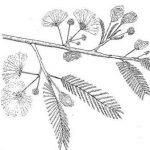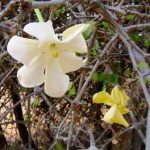TREE LIFE
September and October 1982
MASHONALAND CALENDAR
Tuesday September 7th : Botanic Garden Walk. Meet in the Car Park at 1645 for 1700 hours.
Sunday September 19th : Sable Park, Kwekwe. Bus leaves Monomatapa Car Park at 0700 hours. Fare $15. As usual there will be a security guard to look after our cars during our absence. We plan to return about 1900 hours by which time it will be dark so if any member is reluctant to drive home at that time provision has been made on the booking slip for you to indicate this and we will try and arrange transport for you.
Leaner Group There will be a meeting on Saturday 28th August. If you would like to join us on this occasion, please contact Mrs Gill Masterson on 303435.
DEVELOPMENT WITHOUT DESTRUCTION is the theme of the Natural Resources Board exhibit on the N.R.B. stand at the Harare Agricultural Show from 30th August to 4th September. We are invited to visit this exhibit.
AN INVITATION from Mike and Rose Kimberley, 15 Cheshire Road, Avondale, to see 2 trees presently flowering in their garden and I quote “They are both species of Xanthorrhoea (possibly X. tateana and X. quaorangulata) which occur naturally on the West and East coast of Australia and are commonly known as ‘grass trees’ or ‘black boys’ . .. The one plant has not flowered before this year but the other flowered three years ago (1 spike) and has now produced 2 spikes … I have not heard of the ‘grass tree’ flowering in Zimbabwe before. If anyone would like to have a look at the two specimens they are welcome to pass by at any time.” The Kimberley’s phone number is Harare 39175.
BOTANIC GARDEN WALK AUGUST 1982
Unfortunately at the last minute Mr. Tom Muller was unable to join us for our August Saturday morning Botanic Garden walk. Although it has been my intention to have a walk prepared for such an eventuality that has not yet happened so we were thrown very much on our own resources.
We decided to have a wander round the north western area, one which we have not often visited before. First to catch our attention was Draceana draco which I ventured to say I believed was the ‘real’ Dragon Tree but confessed I remembered little else. I have since consulted Frances Perry, flowers of the World, and it appears that I was right, this is the Dragon tree of the Canary Islands, so called because it exudes a red resinous juice from cracks in the trunk of the tree. This is known as “dragon’s blood”, has no taste and no smell, is very brittle and burns with a bright flame during which it does give off a slight fragrance. Uses for this exudate include, staining marble and the 18th century Italian violin makers use of it as a varnish. And from Eve Palmer in Trees of Southern Africa comes the information that the ‘gum’ from the species D. cinnabari was much prized for religious ceremonies in India. In fact the island Socotra from which it comes is called the Abode of the Blest. I have not been able to discover how many other species exude this gum. The Draceanas which are indigenous to this country are D. reflexa, small leaves Dragon tree, with narrow leaves no more than 2cm wide and D. steudneri, Northern Large Leaved Dragon Tree the one most often grown in our gardens with leaves up to 10cm wide, both of which reach tree proportions and D. fragrans which is a shrub. All three species are inhabitants of the eastern district forests. It is suggested that the name comes from the Greek ‘Draikaina” meaning a female dragon because the juice of these trees becomes a powder like the legend of the dragon’s blood. Does anyone know that legend and if so would they please be good enough to pass it on to me?
We also had a look at the Podocarpus or yellowwood genus. Podocarpus latifolius is the only species which grows in our country – so we can just call it the Yellowwood. In South Africa there are four species – P. elongatus, the Breede River Yellowwood which comes from the south western Cape; P. henkelii, an inhabitant of the forests of Natal East Griqualand and the two well known species of yellowwood timber fame, P. latifolius known as the Real True or Upright Yellowwood and F. falcatus known as the Common or Outenique Yellowwood and is the “Big Tree” in the Knysna Forest. Another famous Knysna forest tree which we look at later was Ocotea bullata, the Stinkwood. The specific name comes from the fact that there are little pits in the axils of the veins on the under surface of the leaves giving a corresponding bump of bubble on the upper surface which are called ‘bullae’ from the Latin bulla – a bubble.
Many of the trees in the South African section were unlabelled and Tom has since been round with Lola and I and so here are some of the answers to some of our mysteries. The first tree with milky sap is Mimusops caffra, Coast Red-milk wood which occurs along the coast from just south of Beira to about East London and underneath its branches is Carissa macrocarpa which also has Y thorns. Also a coastal species this is the Carissa with the largest fruit and is known as the Large Num-num. The fig with the huge leaves and spreading horizontal branches is as we thought Ficus trichopoda. It used to be called F. hippopotomi and was given that name by Rev. Jacob Gerstner because in Zululand the distribution of this tree and that of the hippopotamus was very much the same and the Zulu name for both the tree and the animal are the same umVu or umVubu. Unfortunately someone else had given this tree another name in another place at an earlier date.
We recognised a Brachyleana and now I can tell you that is B. discolor and as other species also have dense white hairs on the under surface we can be forgiven for not guessing. The 2 little glands at the base of the leaf, or the top of the petiole, which ever you like, confirmed our guess at Croton, this is C. steenkampianus from the rivers and swamps of Natal. Also from Natal the Baphia (which had some of us baffled) B. racemosa with its small white pea-like flowers and amazingly large seeds. With its leaves turning red and small pods unmistakably Combretum is C. krausii, and the Gardenia is G. thunbergia.
Those were our good guesses. Not so clever, what we thought looked like a Nuxia but has alternate leaves is Noltia africana with a striking red leaf amongst the green, Protorhus longifolia; Erythrina lysistemon looking beautiful is our own eastern districts lucky-bean tree which does also occur in the Transvaal, Natal, Swaziland and the Transkei. And as we moved into an area of more recently planted trees which were labelled the Cabbage Tree what we saw was Cussonia nicholsonii, its leaves twice compound, the first division digitate and those leaflets divided into further leaflets.
We all enjoyed the sun, the company and the guessing and I hope these notes will help anyone who cares to return for a re-cap of the trees which grow south of us.
GILNOKIE FARM, ARCTURUS, 15TH AUGUST 1982
Should we or should we not change the venue for our August outing was the burning question. Why? Because two days previously a fire had swept through and burnt out the whole area. However, as August is probably the most leafless time of the year we like to try and choose a riverine venue and as the fire had stopped along the banks of the rivers at Gilnockie farm in the Arcturus district it was decided that we would stick to our original plan and I am quite certain that the 30 people who made the trip were perfectly happy with the decision. It is a lovely spot.
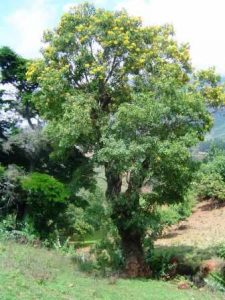
Pterocarpus rotundifolius in flower. Photo: Bart Wursten. Source: Flora of Zimbabwe
We walked down a short in distance, long in grass path to the first stream where there was a large Pterocarpus rotundifolius, round-leaved Bloodwood to greet us. It was unnecessary for me to get out my knife and slash the stem as to make it bleed as the tree was still covered in pods just like little miniature mukwa pods but without the prickles in the middle; also there were still some leaflets, nearly as broad as they are long demonstrating most satisfactorily the specific name which comes from Latin rotundus – round, folium – leaf; meaning with round leaves. The generic name originates from Greek, pteron, wing and karpos fruit giving us winged fruit. The next to catch our attention was a multi stemmed Peltophorum africanum, African wattle, with 8 or 9 trunks all at least 30cm diameter all perched up on an anthill. One of the larger trunks, we discovered once we really craned our necks was not part of the Peltophorum at all but, thanks to the aid of binoculars, we were able to identify it as a Msasa, Brachystegia spiciformis. Next to vie for attention was Bequaertiodendron magalismontanum for which the common name stem fruit is definitely allowed as the botanical name is a frightening mouthful for a lovely tree. The generic name comes from Joseph Charles Bequaart, a Belgium botanist and magalismontanum because it grows on the Magalisberg in South Africa. Obviously that was where it was first collected as it also occurs in Guinea, Zaire, Tanzania, Angola, Zambia and Malawi as well as in Zimbabwe and other parts of South Africa where on the whole it is rather small and stunted, not reaching the size and shape of many of ours. The leaves are glossy green above and silvery to cinnamon on the under surface, this colour is caused, so I read, by appressed hairs. We should obviously have had our lenses out to look at these “hairs pressed together.” The flowers and of course subsequently the fruit are borne on the stems, sometimes on quite old wood as we saw frequently on Sunday from the position of the buds which were prolific. I have only seen green fruit, the birds and beasts having beaten me to the ripe fruit which is described as oval and up to about 1” long and bright red.
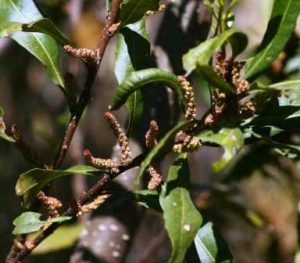
Myrica serrata. Photo: Bart Wursten. Source: Flora of Zimbabwe
As we crossed the stream at a spot where it narrows to flow between the bank and a lovely sloping flat piece of granite on our left we spotted Myrica serrata and on our right Salix subserrata. Although not of the same family they are fairly closely related. Salix subserrata, Wild willow, belongs to the family SALICACEAE and has extensive distribution in Africa from Egypt to the Transvaal and Natal, it also occurs in Israel and Syria. In the southern part of the African continent the genus is represented by S. mucronata, Cape Willow. Having read the similarities and differences I believe the botanists could do well to sink the one under the other.
Am I inviting yet another name change? Mr. Bob Drummond in ‘Common Trees of the Central Watershed Woodlands” comments that the well known cultivated Weeping Willow is Salix babylonica and that to date only female trees have been introduced so that almost all the trees we see have been planted, those that have become naturalized are as a result of accidental vegetative propagation. There is another famous Salix, S. coerulea, the wood of which is used for making cricket bats in England and has become known as the Cricket–bat Willow. MYRICACEAE, the family to which Myrica serrata belongs is the next one on the botanical order list used by the Zimbabwe Herbarium. This is known as the Waxberry family which comes from the fact that what is known as a wax, but which is really a true fat, can be obtained by boiling the fruit. The best known source of this “berry wax” is M. cordifolia, a shrub and inhabitant of the Cape. M. serrata, Lance-leaved Waxberry grows on the edge of rivers, has alternate leaves with a serrate margin (as the name suggests) all of which characters can be used to describe the Wild Willow, Salix subserrata. However, they are completely distinguishable. The lance-leaved Waxberry has yellowish green leaves which are conspicuously gland dotted and margins which are jaggedly serrate. The Wild Willow has leaves that are pale to almost silver/grey on the under surface with finely serrate margins (subserrata comes from Latin sub-under, serra-saw, meaning very finely notched or saw toothed) and they are borne on red petioles on red branchlets and are inclined to droop in true willow fashion. The other riverine species with serrate margins is the River Nuxia, Nuxia oppositifolia which as the name suggests is distinguishable because it has opposite leaves. That we did not see on Sunday.
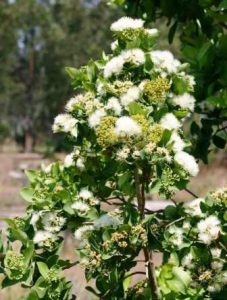
Syzygium cordatum, Waterberry flowers. Photo: Bart Wursten. Source: Flora of Zimbabwe
We wondered on down this first stream, past a Syzygium cordatum, Waterberry, in flower with the myriad of stamens to make it conspicuous and near the confluence of the two streams, we came across an enormous Dodonea viscosa, sand olive, one of the largest most of us have ever seen. It is usually completely unmistakable with its resinous looking shiny light green leaves which have a distinctive smell when crushed, and fruit resembling miniature combretum pods until closer examination reveals that they are more often 2 or 3 winged than 4 winged. These were green with a pink tinge and will dry to a straw colour. Close by was what we eventually decided was Pleurostylia africana, Northern Coffee-pear. This belongs to the family CELASTRACEAE as do the general Maytenus and Cassine and it can be confused with Cassine matabelica both having opposite leaves but C. matabelica has leaves with a serrate margin and P. africana has leaves with an entire margin and when held up to the sun the veining is seen to be conspicuous and close perhaps reminiscent of an association with a lung. Pleurostylia can also be confused with Tarenna neurophylla but that is a member of RUBIACEAE and so has inter-petiolar stipules and even if the stipules have fallen off the inter-petiolar ridges are still present.
Having reached the confluence, we turned right and wandered up the second stream; there was a longish stretch with not much in the way of trees but at one spot a reed cormorant was so intently watching the water that he appeared not to notice us. A little further on was a huge strangler fig, probably Ficus thonningii (F. burkei) which having strangled its host now appeared to be strangling itself. Next to it was an Acacia which we all agreed was Acacia goetzei subsp. goetzei which I believe we are beginning to recognize now. In Trees of Southern Africa I see we called this the purple-pod Acacia, perhaps the veined pod would be more appropriate.
Having again reached the riverine trees we found a Faurea and so started on of the day’s speculations, was it i) Faurea saligna ii) a riverine sub-species iii) a hybrid of F. saligna and F. speciosa, iv) a new species of its own. We shall probably have to await a revision of the genus before we have a final answer. Most of the many trees we saw appeared to have hairless (glabrous) leaves like F. saligna but they were not as narrow and gum-tree-like as they usually are and the flower heads appeared to be like those of F. speciosa. we have since learned that the specimens sent into the Herbarium were definitely identified as F. saligna and there was no further comment!!
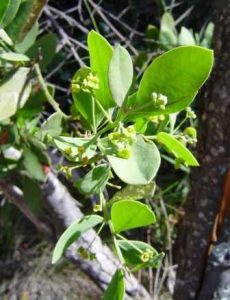
Osyris lanceolate. Photo: Bart Wursten. Source: Flora of Zimbabwe
The water meandered between granite rocks and grassy banks and over and under exposed roots, at all times musical and we kept our eyes and ears in that direction rather than the other way where all was black and rather desolate and our eyes were well rewarded for being kept river wise. There was a lovely clump of stem fruit, Bequaertiodendron magalismontanum whose stems were covered in orchids, so much so that I think it could have a little trouble finding a place for its fruit. And in that same clump was a Mimusops zeyheri, unmistakable with its milky sap and long petioles and also Osyris lanceolate, Bark-bush in flower, green and nearly ripe fruit. This is another species we do not often see. Bark bush comes from a combination of Afrikaans Bergbas and Basbessie which originates from the fact that the Voortrekkers used the bark of this bush for tanning.
The Brachystegia glaucescens, mountain Acacia were lovely with those weird knobs on the trunks and the grey bark flaking in discs and were quite distinctive albeit without any leaves. One had a Hammerkop’s nest in a fork. The Ornytypes assured us that there were owl pellets underneath so at that moment of time the Hammerkop was non-resident. However what was resident, in almost every tumble of rocks around about were huge clumps of the Orchid Ansellia gigantea, some in bud, a promise of the approaching spring.
And then we reached our objective, The Pool, fed by the water running down a dwala, something like a miniature Mermaid’s Pool. I suggested that the satiated and weary rest by the pool in the shade of some waterberry, Syzygium cordatum, and our a typical Faurea saligna while the energetic took a brisk walk up to the neck, merely glancing briefly at the trees as we passed. Having done that walk on the recce I knew how lovely it was and was delighted at the number who elected to come.
This stream obviously has large catchment area as we often saw driftwood caught in branches and against rocks indicating that when in flood it must be extremely broad. Looking at a map I see that after what I have called the first stream and the second stream join they are called the Mapfeni river which is not very long. It crosses the Mrehwa road just beyond the Christian Road and then joins the Umwindsi River almost due east of Ewanrigg.
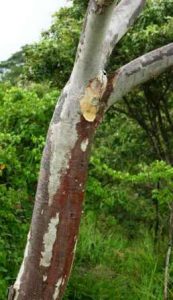
Sterculia quinqueloba. Photo: Bart Wursten. Source: Flora of Zimbabwe
We had lunch along the banks of the first stream in the shade of our giant Peltophorum and in the afternoon split into groups, crossed both streams and wandered through the Msasa woodland to see how many species each group could find. The counts varied from 52 to 62 and the most surprising species found was Schotia brachypetala, weeping schotia, and some of the loveliest were Sterculia quinqueloba with its pink and mottled bark; Combretum zeyheri full of large pod; Parinari curatellifolia, muhasha or mobola plum along the bottom of a dwala so that we could see the lower branches which were covered in bud and flower. The short branched heads, panicles, on which the flowers are borne and the buds are a rusty-browny-yellow. They cover the top of the tree and spill down the side of the round crown, and are inclined to give our old friend the Parinari a different look at this time of the year. The flowers are small, white and sweetly scented and have to be looked for amongst the khaki flowering branchlets.
Having gone out on the Arcturus road we returned via the Cromlet and Mtoko roads. The Msasas were just starting to develop their colours and the late afternoon sun catching them rounded off a lovely day.
And finally, thank you to Mrs. Peggy Clarke and her family for allowing us to visit Gilnockie. We are sorry that you were not able to join us.
-Meg Coates Palgrave
MATABELELAND BRANCH CALENDAR
Sunday September 19th : Sable Park, Kwekwe. This area has much intrinsic interest and a herbarium and an active Wild Life Society. It should be a day of good trees and good company. See “Calendar Tree Life No. 30 and No. 31, Sunday 19th September for information and details. Please plan for this and keep the date clear. The Society has offered to make a contribution towards the cost of all cars making the trip because it is not practical for us to hire a bus. To arrange sharing of transport please contact either the Secretary, Miss Janet Webber, telephone 66039 or Chairman, Mrs. Dora Webb, telephone 42716 preferably by 10th September, but if at the last minute i.e. 18th September you find you can make it, I am sure it will be possible for you to do so.
We hope to have a big contingent to represent Matabeleland for this special occasion.
Sunday October 3rd : To Rhodes Matopos National Park where there will be new leaf and possibly blossom. Meet at Retreat at 0830 hours.
Miss Janet Webber has sent us an article on Tshalabala Game Sanctuary which the Matabeleland Branch visited recently and which we shall include in a future Tree Life.
Meg Coates Palgrave Chairperson
THE IMPORTANCE OF REGROWTH
In 1974 we observed the international year of the tree and many Eucalyptus seedlings were planted in the communal lands. Since December 1980, in accordance with the expressed wish of the Prime Minister, we have joined in the annual tree planting ceremonies. During the last few years the Tree Society has been associated with indigenous and exotic tree planting all over the country, and also in a number of exercises aimed at encouraging natural regeneration and the results of these are available for anybody to see if they are interested. The positive conclusion is that whilst planting is important, so also is natural regeneration, and we believe that our small experiments conclusively show that regeneration need not be as slow as it sometimes believed.
I should like therefore to repeat an earlier appeal that in this coming December, when we symbolically plant trees on the first Saturday, we include some symbolic regeneration ceremonies to illustrate the importance of this aspect of re-afforestation. In areas of poorer than average soil and climatic conditions and in particular where planted trees could not be watered such regeneration protection ceremonies could extend the actual coverage of the National Tree Day.
In any planned land management for our communal areas, exotic plantations which are relatively labour intensive all the year round can only cover a small percentage of available land. In an average communal area in the medium to high rainfall part of the country, after subtracting arable and better quality grazing land, an approximation of the amount of the wooded rough grazing land comes out at about between 40% and 60%.
It is from this area that the people collect most of their fuelwood and building materials, together with those important items of peasant economy, fruit, medicine, small game, honey, bark fibre etc., which are not usually available within the exotic woodlots. Population pressures are such that unless planned management, which includes protection of natural regrowth and subsequent cropping on a controlled yield basis, is commenced immediately the whole of this area will degenerate into complete degradation, the first step towards semi desert. Natural regrowth is a subject on which I have been unable to find any expert advice in the form of written literature.
The ancient wisdom found widely where tribal tradition still is strong, whereby trees harvested for fuel or poles are cut off at about waist height, is not the idleness I have sometimes heard it labelled. This custom ensures that the re-generation would get away quickly and get above the dangers of fire, frost and browse in the first season. In many densely populated communal lands demand is such that this ancient wisdom cannot now be followed, the result of clear felling down to ground level, where the first season’s regrowth is neither as strong or fully protected from danger, can be seen in devastated areas which one does not have to travel far from the capital city to find.
Planned regeneration is in fact easy and much less labour is involved than in establishing exotic plantations. True, the yield of timber acre by acre will be much less, but the overall yield, when one takes into account all the other benefits detailed previously, will be much larger.
What I should like to see is, wherever possible, members and others interested, who control a chunk of ground, unused or waste, call it what you will, make a programme to first look for natural regeneration and then protect it from fire and trampling, and the speed at which growth takes place will be quite startling. The piece of waste ground concerned can be an odd corner of only a few square metres in factory grounds or garden, or larger areas such as the perimeter of school grounds, road verges and unused public land.
This is an appeal to anyone concerned with planning the coming December National Tree Day to publicise the aspect of regeneration as an extension of very essential “planting” – I believe they will be serving an extremely important need.
-George Hall
I have always thoroughly endorsed all George has said in connection with regeneration. The perfect example of the result of protection from chopping and fire is at the Arboretum at Lake McIlwaine. About 20 years ago the vegetation was but scrub, waist high, now on the lower slopes where there has been selective clearing the trees are huge and the area park-like. Higher up the hill, where the trees have merely been allowed to “do their own thing” there is no longer a view of the lake and the trees form a canopy 6 – 10m up, although they are rather close together and their trunks rather spindly.
With reference to regrowth ceremonies, I should like to put forward the practical suggestion that a stump/sapling/whatever could have a basin made round it and stones placed on the edge of this and a symbolic bucket of water could be poured into the basin. The stones would signify that this is something special (perhaps they could be white-washed) and help maintain the basin, which would increase the water reaching the roots of the tree when it rains.
-Meg Coates Palgrave


